uniface
Silver Member
and a nice overview history of the collective mental illness that still paralyses archaeology in north America (and, as emotion replaces reason, everything else). It's a good way to get up to speed on the issue if you're not familiar with it.
https://exploringrealhistory.blogspot.com/2020/07/part-2-america-before-key-to-earths.html
ALTHOUGH HE HIMSELF IS NOT an archaeologist, Tom Deméré, curator of paleontology at the San Diego Natural History Museum in California, does have occasion to work with archaeologists. I was therefore not surprised when his response to my request to interview him and have him show me certain stones and bones in the museum’s archives was declined. My initial approach was on September 18, 2017, and the polite refusal came on September 20, not from Dr. Deméré himself but from Rebecca Handelsman, the museum’s communications director. “While we’re unable to accommodate your request for a meeting,” she wrote . . .
Deméré had been closely involved from the outset with the excavation of a controversial site near San Diego and had published a paper in 2017 claiming that humans had been present there as early as 130,000 years ago. The paper was a prominent one, since it appeared in the prestigious scientific journal Nature, and almost immediately aroused the fury of archaeologists committed to a much later date for the peopling of the Americas.
. . . Indeed by 2012 the bullying behavior of the Clovis First lobby had grown so unpleasant that it attracted the attention of the editor of Nature, who opined: “The debate over the first Americans has been one of the most acrimonious—and unfruitful—in all of science. … One researcher, new to the field after years of working on other contentious topics, told Nature that he had never before witnessed the level of aggression that swirled around the issue of who reached America first.”
. . . Haynes and Adovasio had crossed swords before—over Meadowcroft, a site in Pennsylvania that Adovasio had excavated in the 1970s that revealed eleven well-defined stratigraphic units with evidence of human occupation “spanning at least 16,000 years and perhaps 19,000 years.” Inevitably, because it threatened Clovis First, this attracted the hostility of Haynes, who, in the years that followed, sought to quibble away almost every aspect of Adovasio’s evidence: “In scientific paper after scientific paper, Haynes … asked for yet another date, yet another study, raising yet other picayune and fanciful questions about Meadowcroft, most of which had been answered long before he asked them—not just in the original excavation procedures but in report after report.”
. . . Likewise, in the 1990s, Canadian archaeologist Jacques Cinq-Mars excavated Bluefish Caves in the Yukon and found evidence of human activity there dating back more than 24,000 years—older than Meadowcroft and much older than Clovis. The price he paid was high. His competence and his sanity were questioned and when he attempted to present his findings at conferences he was ignored or insulted.
As a result of such attitudes, funding drained away and Cinq-Mars had to stop his work, only to be proved correct, many years later, by a new scientific study of the evidence from the caves published in January 2017.
Only 4 months later, on April 27, 2017, Tom Deméré’s paper announcing the discovery of “a 130,000-year-old archaeological site in southern California, USA,” appeared in Nature . . .
https://exploringrealhistory.blogspot.com/2020/07/part-2-america-before-key-to-earths.html
Upvote
0





